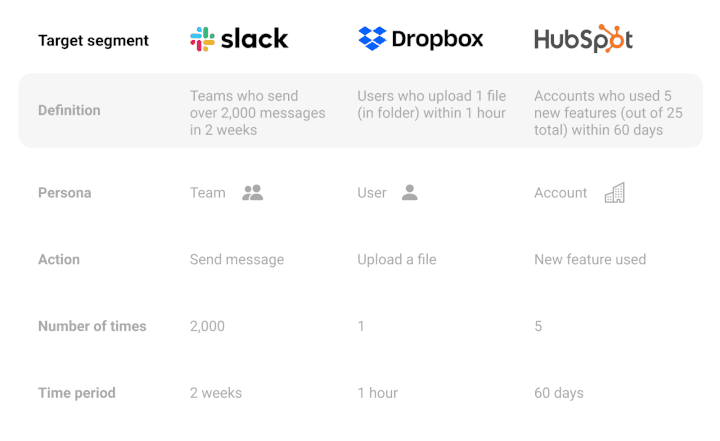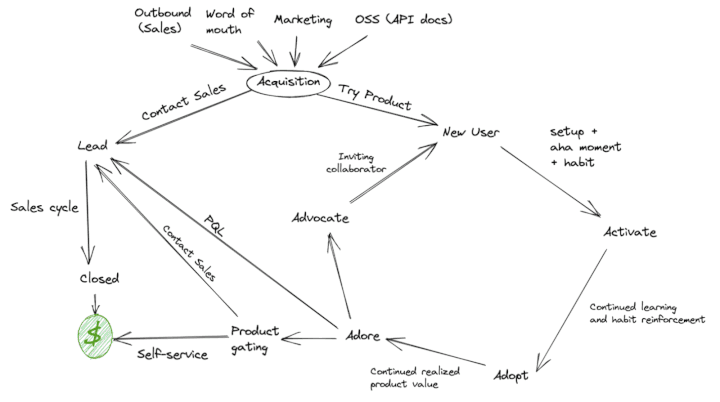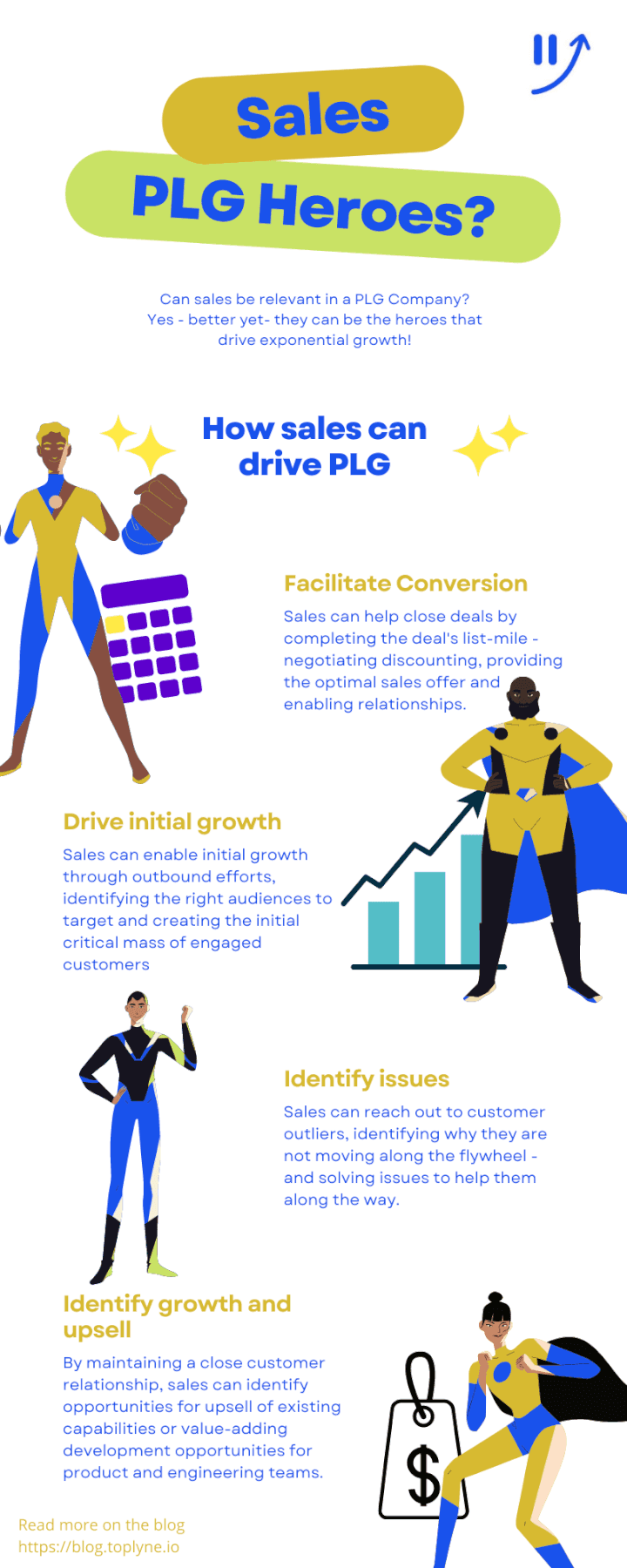PLG & Sales - name a more iconic duo, we'll wait
PLG & Sales - name a more iconic duo, we'll wait
PLG & Sales - name a more iconic duo, we'll wait
Busting the myth of "no-Sales" at product-led growth companies and exploring the many roles that Sales can play
Busting the myth of "no-Sales" at product-led growth companies and exploring the many roles that Sales can play
Busting the myth of "no-Sales" at product-led growth companies and exploring the many roles that Sales can play



After the onset of Covid-19, the world witnessed two years' worth of digital transformation in just two months. Every company started becoming a software company. The distance between buyers of software and the end-users has been on a steady decline over the last two decades, as the marketing and sales-led motions fell by the wayside, paving the path for product-led trailblazers. Today, anyone with a laptop and an internet connection can set up their own website on Webflow, export professional designs on Canva, write code and build apps using Replit, generate marketing copy using Copy.ai, and more - all for free. Product-Led Growth is lowering the barriers to entry and pioneering the democratization of software and tech.
Revolutionary technological innovations such as cloud computing, the no/low-code movements, easy access to programming frameworks, developers, and learning have created a glut of SaaS startups that are looking to solve multiple problems - and in a lot of cases, have built strong solutions.
PLG companies look to drive the adoption of their products through a combination of freemium offers, fast delivery of value to users, and a sales motion built on a foundation of strong product analytics. The go-to-market motion for software is increasingly moving away from being sales-led, or marketing-led. Adoption is driven by product experience and word of mouth, through user invites and experience videos - all from the product, generated by actual users. Few buyers have the patience or time to review a website, even with review websites such as Gartner PeerInsights and G2Crowd becoming a trusted source of information.
As described in the book From Incremental to Exponential, these companies are using exponential technological innovations across the industry (cloud computing, simpler voice/video/messaging protocols, better development frameworks) to create solutions that customers love, and are making them move away from traditional leaders in their industries.
These firms rely on their product and a friction-free experience to win customers. Sales teams are extensive, but they serve auxiliary roles and serve to drive incremental growth. These PLG firms are displacing traditional incumbents rapidly.
🤷🏻♀️ What role do Sales teams play at PLG companies?
In a PLG (product-led growth) company, Sales dons a few hats:
PQLs - At the best PLG companies, sales teams have a bird’s eye view of PQLs (Product Qualified Leads) and assist their conversion to paid plans. More on PQLs later.
Enterprise - Large-scale SaaS deployments have several points of friction: too many decision-makers, multiple conflicting priorities and users not being the buyers, budget difficulties, and internal users being unwilling to navigate the red tape needed to finalize a purchase decision. Sales is critical to facilitating requirements such as conversations and clarifications for different customer user groups, and ironing out the ideal pricing-discounting mix to close deals. A one-size-fits-all sales model can work for individuals, but rarely for enterprises.
While the traditional sales customer is tolerant towards multiple touchpoints, today’s PLG-SaaS customer looks for autonomy within their product journey wherever possible. But as the team that best understands customer problems and can quickly communicate them to product teams, Sales can step in when necessary.
Sales can continually evaluate potential business expansion opportunities and push the ideas back to product teams. For individuals, sales can track opportunities for value expansion (as an example, sales could identify that a team is looking for a means to run analytics on their product development data in a PLG product - and provide that additional module if it is already available/in beta)
Enabling PLG: On several occasions, the initial use of the product itself (whether trial or freemium) may need a sales push. In some cases, it may be useful to offer a customized trial/freemium offer to enable large opportunities - such as a large organization that may need to transition over from a different tool. Other cases include organizations that need some custom training. In all these cases where a custom engagement is called for, sales can actually enable the PLG process itself.
Sales can also be a key partner in enabling PQLs and power users to transition into product champions within teams and organizations.

Product-Qualified Leads
A PQL (or Product Qualified Lead) is a freemium or trial user who has hit an ‘activation’ metric. Typically, an organization needs to scour user data to profile users who have reached a level of product usage that has primed them for conversion to a paid plan.
For Slack, a PQL was teams who sent over 2,000 messages in 2 weeks
For Dropbox, it was users who uploaded 1 file in 1 hour of signing up
And for Hubspot, it was accounts that used 5 (out of 25) new features within 60 days.

🙋♀️ The Where - Where do Sales teams intervene?
Product discoverability is a key determinant of how useful sales can be, both as an outbound and inbound customer acquisition mechanism.
For tools such as Retool, outbound sales became a key determinant for customer success in the beginning; tools that can provide capabilities that are unfamiliar to users require user education to drive adoption - which is why, Retool’s founders themselves drove outbound sales through a targeted campaign using Crunchbase for identification of firms, Upwork to find individual stakeholders and PersistIQ to automate and run the campaign itself. After the initial push from the founders, Retool quickly pivoted to a largely inbound motion, before ultimately layering in an outbound sales motion later.
Sales is critical to enabling hypergrowth for new, high-potential SaaS companies. Most organizations don’t know the product exists, so targeted outbound is critical.
Once the software reaches a critical mass of users, it can self-sustain; but until then, it will need the support of a sales function to drive adoption. Here’s a view of what Sourcegraph thinks their ideal flywheel will look like.

Acquisition has several vehicles - and outbound sales and marketing are two critical ones.
Inbound sales also plays a critical role in the PLG ecosystem: Inbound sales is essential to quick incorporation of qualified leads.
Post the Adore stage, when a customer is completely sold on the solution, sales can hand-hold the customer through the buying cycle, providing appropriate discounting and identifying the solution best-fit among the available options

🙋♀️ The When - When do Sales teams intervene?
The Activate Stage - As you guide evaluators to their “Aha” moment where they start to truly realize their needs from the product and immerse in the product experience, evaluators will use in-product help and guided walkthroughs to identify how your product can fulfill their immediate need. But amidst these users, there will be some users of critical importance - leaders who are investigating a new product, or a key influencer who could introduce the product to a decision-maker. Sales should identify these users from their profile details and carefully nurture them through a personalized approach, as these users could be a gateway to large enterprise deals.
The Adopt Stage - At the adopt stage, beginners are typically looking for the best ways to integrate your product into their workflows and processes. While most users will explore, sales should keep track of users who seem to be stuck in the beginner stage for too long with usage dropping off. These users are having trouble identifying the right means to integrate - and sales may want to bring the right technical and product resources on board to enable their transition to regulars.
The Adore and Advocate Stages - When users reach this stage, sales can actively identify potential candidates for product references, influential users, and eventual conversions to paid/premium plans - which will need some good old-fashioned research, setting up an infrastructure to investigate product-usage data and identify product-qualified leads. Or just use Toplyne.
After the onset of Covid-19, the world witnessed two years' worth of digital transformation in just two months. Every company started becoming a software company. The distance between buyers of software and the end-users has been on a steady decline over the last two decades, as the marketing and sales-led motions fell by the wayside, paving the path for product-led trailblazers. Today, anyone with a laptop and an internet connection can set up their own website on Webflow, export professional designs on Canva, write code and build apps using Replit, generate marketing copy using Copy.ai, and more - all for free. Product-Led Growth is lowering the barriers to entry and pioneering the democratization of software and tech.
Revolutionary technological innovations such as cloud computing, the no/low-code movements, easy access to programming frameworks, developers, and learning have created a glut of SaaS startups that are looking to solve multiple problems - and in a lot of cases, have built strong solutions.
PLG companies look to drive the adoption of their products through a combination of freemium offers, fast delivery of value to users, and a sales motion built on a foundation of strong product analytics. The go-to-market motion for software is increasingly moving away from being sales-led, or marketing-led. Adoption is driven by product experience and word of mouth, through user invites and experience videos - all from the product, generated by actual users. Few buyers have the patience or time to review a website, even with review websites such as Gartner PeerInsights and G2Crowd becoming a trusted source of information.
As described in the book From Incremental to Exponential, these companies are using exponential technological innovations across the industry (cloud computing, simpler voice/video/messaging protocols, better development frameworks) to create solutions that customers love, and are making them move away from traditional leaders in their industries.
These firms rely on their product and a friction-free experience to win customers. Sales teams are extensive, but they serve auxiliary roles and serve to drive incremental growth. These PLG firms are displacing traditional incumbents rapidly.
🤷🏻♀️ What role do Sales teams play at PLG companies?
In a PLG (product-led growth) company, Sales dons a few hats:
PQLs - At the best PLG companies, sales teams have a bird’s eye view of PQLs (Product Qualified Leads) and assist their conversion to paid plans. More on PQLs later.
Enterprise - Large-scale SaaS deployments have several points of friction: too many decision-makers, multiple conflicting priorities and users not being the buyers, budget difficulties, and internal users being unwilling to navigate the red tape needed to finalize a purchase decision. Sales is critical to facilitating requirements such as conversations and clarifications for different customer user groups, and ironing out the ideal pricing-discounting mix to close deals. A one-size-fits-all sales model can work for individuals, but rarely for enterprises.
While the traditional sales customer is tolerant towards multiple touchpoints, today’s PLG-SaaS customer looks for autonomy within their product journey wherever possible. But as the team that best understands customer problems and can quickly communicate them to product teams, Sales can step in when necessary.
Sales can continually evaluate potential business expansion opportunities and push the ideas back to product teams. For individuals, sales can track opportunities for value expansion (as an example, sales could identify that a team is looking for a means to run analytics on their product development data in a PLG product - and provide that additional module if it is already available/in beta)
Enabling PLG: On several occasions, the initial use of the product itself (whether trial or freemium) may need a sales push. In some cases, it may be useful to offer a customized trial/freemium offer to enable large opportunities - such as a large organization that may need to transition over from a different tool. Other cases include organizations that need some custom training. In all these cases where a custom engagement is called for, sales can actually enable the PLG process itself.
Sales can also be a key partner in enabling PQLs and power users to transition into product champions within teams and organizations.

Product-Qualified Leads
A PQL (or Product Qualified Lead) is a freemium or trial user who has hit an ‘activation’ metric. Typically, an organization needs to scour user data to profile users who have reached a level of product usage that has primed them for conversion to a paid plan.
For Slack, a PQL was teams who sent over 2,000 messages in 2 weeks
For Dropbox, it was users who uploaded 1 file in 1 hour of signing up
And for Hubspot, it was accounts that used 5 (out of 25) new features within 60 days.

🙋♀️ The Where - Where do Sales teams intervene?
Product discoverability is a key determinant of how useful sales can be, both as an outbound and inbound customer acquisition mechanism.
For tools such as Retool, outbound sales became a key determinant for customer success in the beginning; tools that can provide capabilities that are unfamiliar to users require user education to drive adoption - which is why, Retool’s founders themselves drove outbound sales through a targeted campaign using Crunchbase for identification of firms, Upwork to find individual stakeholders and PersistIQ to automate and run the campaign itself. After the initial push from the founders, Retool quickly pivoted to a largely inbound motion, before ultimately layering in an outbound sales motion later.
Sales is critical to enabling hypergrowth for new, high-potential SaaS companies. Most organizations don’t know the product exists, so targeted outbound is critical.
Once the software reaches a critical mass of users, it can self-sustain; but until then, it will need the support of a sales function to drive adoption. Here’s a view of what Sourcegraph thinks their ideal flywheel will look like.

Acquisition has several vehicles - and outbound sales and marketing are two critical ones.
Inbound sales also plays a critical role in the PLG ecosystem: Inbound sales is essential to quick incorporation of qualified leads.
Post the Adore stage, when a customer is completely sold on the solution, sales can hand-hold the customer through the buying cycle, providing appropriate discounting and identifying the solution best-fit among the available options

🙋♀️ The When - When do Sales teams intervene?
The Activate Stage - As you guide evaluators to their “Aha” moment where they start to truly realize their needs from the product and immerse in the product experience, evaluators will use in-product help and guided walkthroughs to identify how your product can fulfill their immediate need. But amidst these users, there will be some users of critical importance - leaders who are investigating a new product, or a key influencer who could introduce the product to a decision-maker. Sales should identify these users from their profile details and carefully nurture them through a personalized approach, as these users could be a gateway to large enterprise deals.
The Adopt Stage - At the adopt stage, beginners are typically looking for the best ways to integrate your product into their workflows and processes. While most users will explore, sales should keep track of users who seem to be stuck in the beginner stage for too long with usage dropping off. These users are having trouble identifying the right means to integrate - and sales may want to bring the right technical and product resources on board to enable their transition to regulars.
The Adore and Advocate Stages - When users reach this stage, sales can actively identify potential candidates for product references, influential users, and eventual conversions to paid/premium plans - which will need some good old-fashioned research, setting up an infrastructure to investigate product-usage data and identify product-qualified leads. Or just use Toplyne.
Related Articles




Behavioral Retargeting: A Game-Changer in the Cookieless Era
Unlock the power of behavioral retargeting for the cookieless future! Learn how it personalizes ads & boosts conversions. #behavioralretargeting




All of Toplyne's 40+ Badges in the G2 Spring Reports
Our customers awarded us 40+ badges in G2's Summer Report 2024.




Unlocking the Full Potential of Google PMax Campaigns: Mastering Audience Selection to Double Your ROAS
Copyright © Toplyne Labs PTE Ltd. 2024
Copyright © Toplyne Labs PTE Ltd. 2024
Copyright © Toplyne Labs PTE Ltd. 2024
Copyright © Toplyne Labs PTE Ltd. 2024